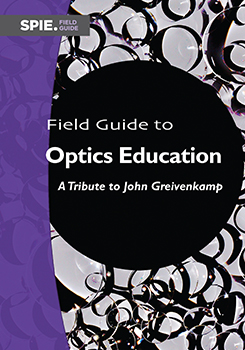Resources for Effective Approaches
Stephen M. Pompea
NSF’s NOIRLab, USA
John Greivenkamp played an important and outsized role in creating larger national plans and blueprints that encouraged and supported optics education at all levels. Our NSF-sponsored OSA-SPIE project for middle-school-aged students,
Hands-On Optics: Making an Impact with Light (Pompea et al. 2005) was just one example of a project that stemmed from John’s commitment to optics education at the pre-college level. John once commented to me about the amount of work involved in creating an optics lesson on color for his daughter’s 4th grade class. I wasn’t at all surprised, as good units take significant time. For most of us, time is in short supply. In the spirit of encouraging efficiency, here are a few tips based on my experiences in teaching optics in classrooms and in outside-of-school settings. Perhaps they will save you time and frustration, making the process more enjoyable.
1. Optics education is equal parts “knowledge and wonder,” as Francis Bacon so aptly described his philosophy: “For all knowledge and wonder (which is the seed of knowledge) is an impression of pleasure in itself,” (Bacon & Montegu 1852).
Knowledge ascertains how the natural world is organized and how the individual pieces work, and work together. When we study how a lens or mirror works, we are helping build investigative knowledge on refraction and reflection. Equally important, though, is the sense of wonder. This can be wonder that there are indeed laws that govern refraction and reflection, and that these laws can be determined through careful observation. There is also the wonder of observing the images created by lenses or mirrors. Equally impressive, though harder to explain, is a rainbow or halo created by complex combinations of simpler effects.
Bacon also emphasized the pleasure derived from these observations. We should remember that enjoyment is a large part of learning. Appreciating the beauty of optical phenomena is a powerful motivator for sustained learning.
2. Optics education is both an art and a science, and needs to incorporate the lessons learned and best practices from both from research studies and the experience of practitioners. The best practices for working with schools and museums are well documented in many ETOP proceedings and can save novices much aggravation and trouble. Some starting points for becoming more effective when participating in science education at the pre-college level can be found in a long review by Pompea & Russo (2020) and in several recent shorter articles (Pompea & Russo 2021a,b).
3. Working with younger learners has the most impact and can be the most rewarding. Children who are 9 or 10 years old are excited about learning science and have great investigative skills. Take advantage of that interest by providing experiments that are learning opportunities. Teach them how to do (play) science. They don’t need to be spectators as they learn the rules of science.
4. Color is a particularly broad and effective teaching area. Much of optics can be explored by young children through their observations and examinations of the colors that occur in nature. A broad review of the possibilities to teach with color is given in Pompea & Carsten-Conner (2015).
5. Optical scientists and engineers are a resource to classroom teachers and museum professionals. Partnering with educators as resource agents is an effective strategy. Educators have the knowledge of pedagogy and how to teach. Optics professionals know the subject and the practical applications of optics. They also know how to obtain equipment that might be useful for simple classroom experiments.
6. Help to build interest in science among children and help them identify with science by developing their science capital. You can do this by fostering a mindset more open to exploring and enjoying STEM topics. A powerful way to achieve this is to incorporate art into STEM subjects (Conner et al. 2019). This provides an additional level of science appeal to art-interested children who may not yet identify with science or who have already had negative science experiences (Conner et al. 2017, Sullivan et al. 2017).
References
Bacon, F. and Montagu, B., “Of the Proficience and Advancement of Learning,” in The Works of Francis Bacon, Lord Chancellor of England, Cary & Hart, 163 (1852).
Conner, L. D. C., Tsurusaki, B. K., Tzou, C., Sullivan, P. T., Guthrie, M., and Pompea, S. M., “Fostering a STEAM mindset across learning settings,” Connected Science Learning 1(12) (2019).
Conner, L. D. C., Tzou, C., Tsurusaki, B. K., Guthrie, M., Pompea, S. and Teal-Sullivan, P., “Designing STEAM for broad participation in science,” Creative Education 8(14), 2222 (2017).
Pompea, S. M. and Carsten-Conner, L. D., “Teaching optics concepts through an approach that emphasizes the ‘colors of nature,’” Proc. SPIE 9793, 97932U (2015) [doi: 10.1117/12.2223238].
Pompea, S. M., Johnson, A., Arthurs, E., and Walker, C. E., “Hands-On Optics: an educational initiative for exploring light and color in after-school programs, museums, and hands-on science centers,” Proc. SPIE 9664, 966425 (2005) [doi: 10.1117/12.2207727].
Pompea, S. M. and Russo, P., 2020, “Astronomers engaging with the education ecosystem: A best-evidence synthesis,” Annual Review of Astronomy and Astrophysics 58, 313–361 (2020).
Pompea, S. M. and Russo, P., “Improving science education: It’s not rocket science—it’s harder!” Physics Today 74(9), 26 (2021a).
Pompea, S. M. and Russo, P., “Ten simple rules for scientists getting started in science education,” PLoS Comput. Biol. 17(12), e1009556 (2021b).
Sullivan, P. T., Conner, L. C., Guthrie, M., Pompea, S., Tsurusaki, B. K., and Tzou, C., “Colorful chemistry,” Science and Children 54(8), 34 (2017).


